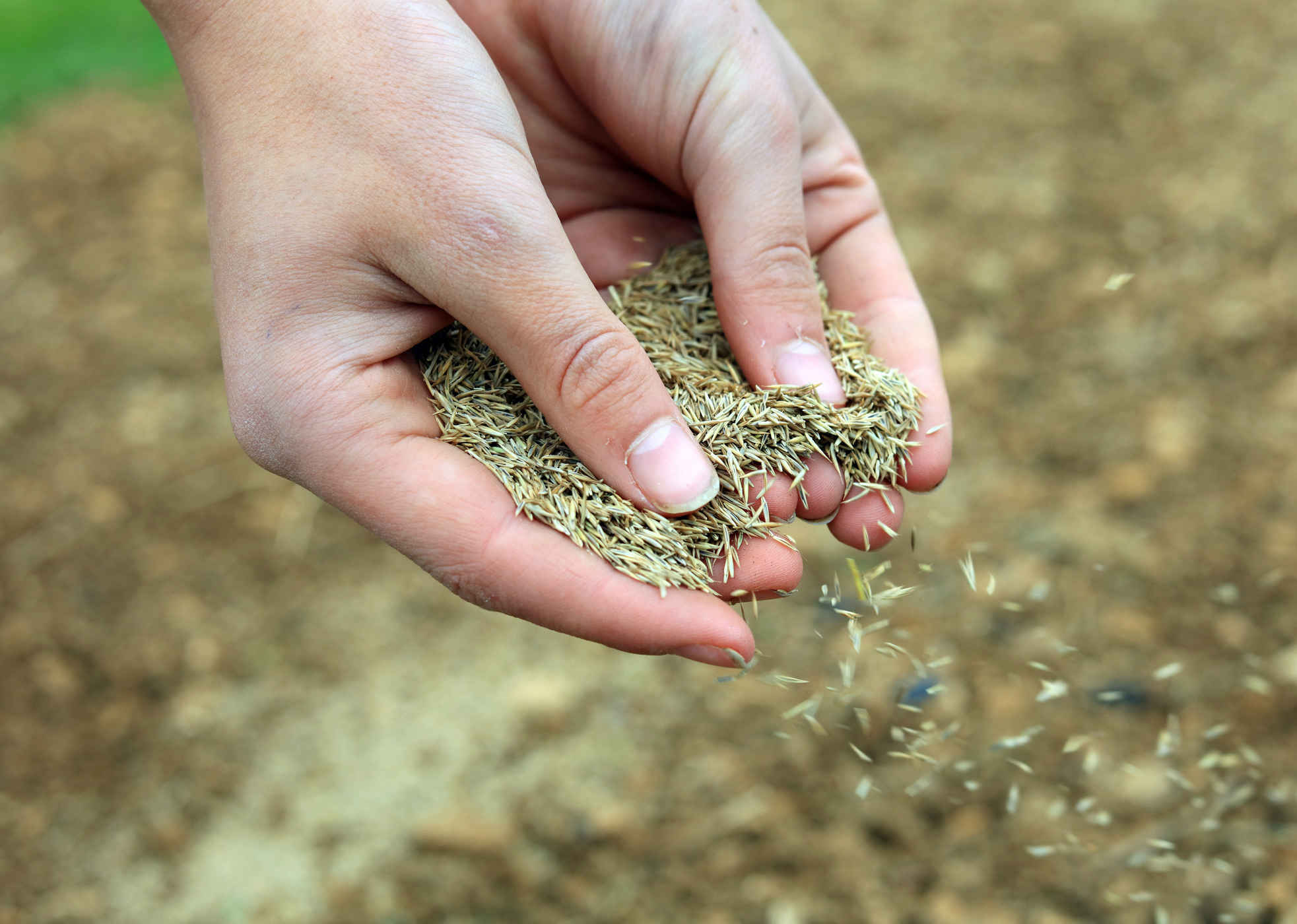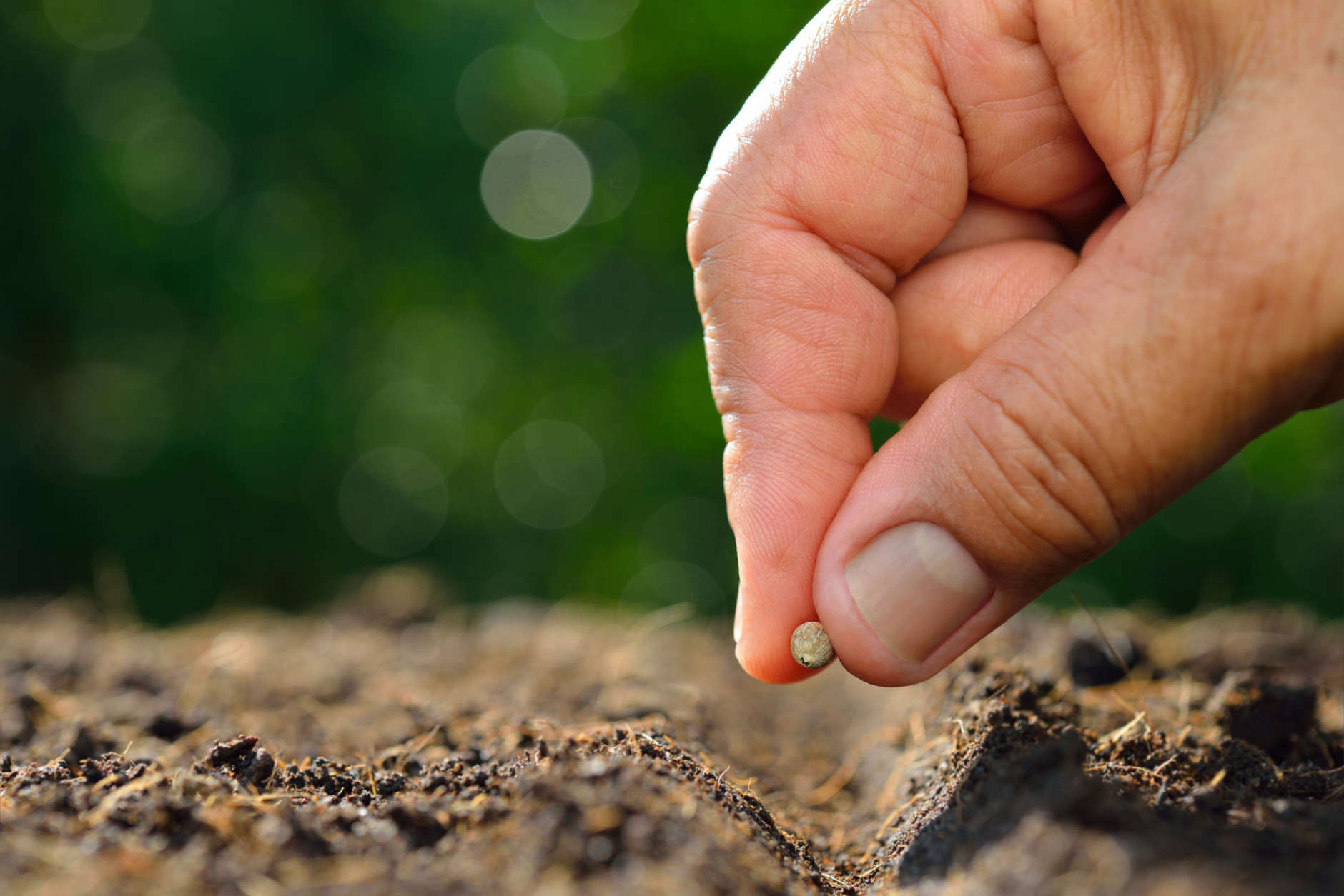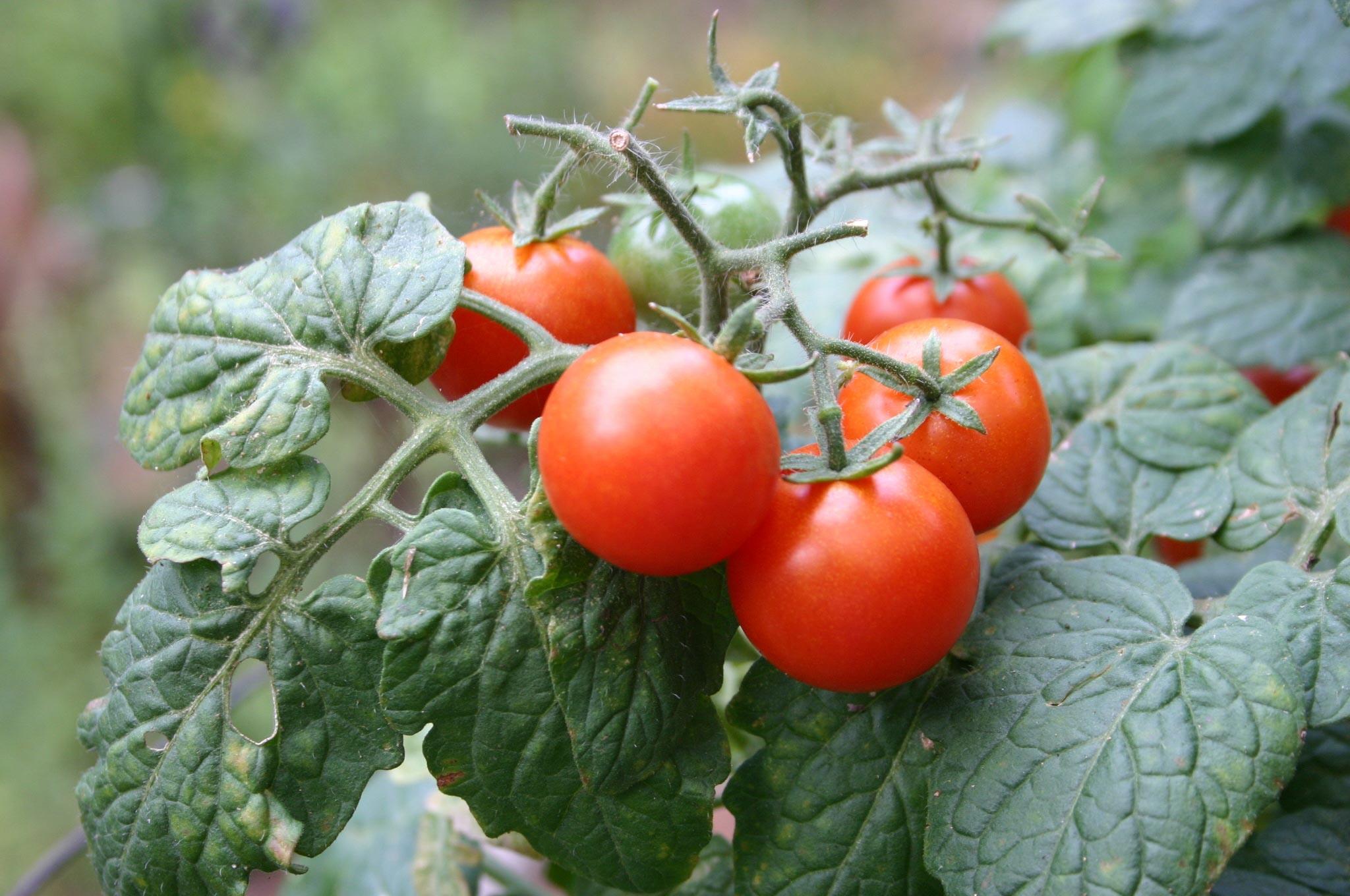Home>Gardening Techniques>Seasonal Gardening>When Can You Start Planting Grass Seed


Seasonal Gardening
When Can You Start Planting Grass Seed
Modified: January 22, 2024
Discover the best time to start planting grass seed with our seasonal gardening guide. Ensure a lush, healthy lawn by following our expert advice and tips.
(Many of the links in this article redirect to a specific reviewed product. Your purchase of these products through affiliate links helps to generate commission for Chicagolandgardening.com, at no extra cost. Learn more)
Table of Contents
- Introduction
- Factors to Consider in Planting Grass Seed
- Best Time to Plant Grass Seed
- Early Spring Planting
- Late Summer to Early Fall Planting
- Late Fall to Early Winter Planting
- Preparing the Soil for Grass Seed Planting
- Choosing the Right Type of Grass Seed
- Proper Way to Plant Grass Seed
- Caring for Newly Planted Grass Seed
- Conclusion
Introduction
Welcome to the wonderful world of seasonal gardening! As a gardener, one of the most exciting and rewarding tasks is planting grass seed. Whether you’re starting a new lawn or rejuvenating an existing one, the process of planting grass seed requires careful consideration and timing. In this article, we will explore the factors to consider when planting grass seed and discuss the best times to plant based on the different seasons.
Growing a lush and healthy lawn starts with choosing the right time of year to sow your grass seed. Understanding the seasonal variations and their impact on grass growth will help you make informed decisions and set your lawn up for success.
Beyond timing, it is also crucial to prepare the soil properly and choose the appropriate grass seed type for your specific climate and soil conditions. Taking these steps ensures optimal growth and a vibrant lawn that will be the envy of your neighborhood.
So, whether you’re a seasoned gardener looking to improve your lawn or a beginner embarking on your first grass seeding adventure, this article aims to provide you with all the information you need to successfully plant and nurture your grass seed.
Factors to Consider in Planting Grass Seed
Planting grass seed is more than just choosing a time of year and scattering the seeds. Several important factors need to be taken into account to ensure successful germination and establishment of your lawn. Let’s explore some key considerations:
1. Soil Temperature: The soil temperature plays a crucial role in seed germination. Different grass species have specific temperature requirements for optimal growth. It’s essential to monitor the soil temperature using a soil thermometer. Planting when the soil temperature is within the recommended range increases the chances of successful seed germination.
2. Moisture: Adequate moisture is vital for grass seed germination. During the germination period, the soil needs to be consistently moist but not overly saturated. Ensure proper irrigation or regular watering to keep the soil moist until the grass seedlings establish.
3. Sunlight: Most grass species require sunlight to thrive. Assess the sunlight exposure in your lawn area. Full sunlight is ideal, but some grass varieties can tolerate partial shade. Choose a grass seed variety that matches your lawn’s sunlight conditions.
4. Soil Condition: The soil condition determines the ability of grass seeds to establish strong root systems. Conduct a soil test to evaluate nutrient levels, pH, and soil structure. Adjust the soil pH and enrich with necessary nutrients if needed to create an ideal environment for seedling growth.
5. Weed Control: Weeds can hamper the growth and development of newly planted grass seed. Prior to seeding, it’s crucial to eliminate weeds and ensure a weed-free zone. You can use herbicides or manually remove the weeds. Follow the instructions carefully to avoid damaging the grass seed or the environment.
6. Time of Year: Choosing the right time of year to plant grass seed is crucial for optimal growth. Different grass species have different preferred planting times. Consider factors such as the climate, temperature, and timing within the grass’s growing season.
By taking these factors into account, you can create the ideal conditions for your grass seed to sprout, grow, and flourish. Remember that proper planning and preparation are key to a successful lawn establishment.
Best Time to Plant Grass Seed
The timing of when you plant grass seed can greatly impact its success. The best time to plant grass seed depends on various factors, including the specific grass species, local climate, and region. Let’s explore the most favorable times to plant grass seed based on the different seasons:
1. Early Spring Planting: The early spring season, when temperatures start to rise but before the heat of summer arrives, is an excellent time to plant cool-season grasses like Kentucky bluegrass and fescue. This allows the seeds to establish roots and grow before the hot summer months. Aim to plant in early spring when the soil temperature reaches around 55°F (13°C).
2. Late Summer to Early Fall Planting: Late summer to early fall is another optimal time to plant grass seed. The soil is warm, and there is typically enough rainfall to support seed germination and establishment. This is particularly beneficial for warm-season grasses like Bermuda grass and zoysia grass. Aim to plant in September or early October for best results.
3. Late Fall to Early Winter Planting: In regions with mild winters, late fall to early winter can be a suitable time to plant grass seed. The soil is still warm enough to foster germination, and there is often ample rainfall. Cool-season grasses such as rye grass and fine fescue can be planted during this time. Aim to plant in late November or early December.
It’s important to note that planting times can vary based on your specific climate and the grass seed variety you choose. Consult local gardening resources or reach out to a gardening expert in your area for personalized recommendations.
Additionally, it’s advisable to avoid planting grass seed during extreme weather conditions, such as very hot or cold periods. Extreme temperatures can hinder seed germination and growth. Keep an eye on the weather forecast and aim for milder and more stable weather conditions when planting your grass seed.
Remember, the best time to plant grass seed ensures that the seeds have favorable conditions for germination and establishment, leading to a healthy and thriving lawn.
Early Spring Planting
Early spring is an ideal time to plant grass seed for cool-season grasses such as Kentucky bluegrass, fescue, and perennial ryegrass. During this time, the soil begins to warm up, and there is usually sufficient moisture to support seed germination and establishment.
One of the main advantages of early spring planting is that the grass seed has the entire growing season ahead to establish strong root systems and grow before the heat of summer arrives. This allows the grass to develop a sturdy base and better withstand the stresses of summer, such as heat and drought.
When planning for early spring planting, keep in mind the following considerations:
1. Soil Preparation: Prepare the soil thoroughly before sowing the grass seed. Remove any debris, rocks, or weeds from the area. Loosen the top few inches of soil using a rake or tiller. This helps create a loose and fertile seedbed, allowing the grass seed to make good contact with the soil for germination.
2. Soil Temperature: Monitor the soil temperature using a soil thermometer. Cool-season grasses tend to germinate best when the soil temperature reaches around 55°F (13°C). Wait until the soil has adequately warmed up to this temperature before planting the grass seed.
3. Seeding Rate and Method: Follow the recommended seeding rate for the specific grass seed variety you are planting. It is generally recommended to sow grass seed evenly using a spreader to ensure uniform coverage. Avoid overseeding or applying too much seed in one area, as this can lead to competition for resources and weak growth.
4. Watering: Adequate watering is crucial during the early stages of seed germination and establishment. Water the newly planted grass seed lightly and frequently to keep the soil consistently moist. Be cautious not to overwater, as this can lead to waterlogging and hinder germination. As the grass seedlings begin to grow, gradually reduce the frequency of watering but increase the amount of water applied to encourage deep root growth.
5. Fertilization: Apply a starter fertilizer specifically formulated for new seedlings to provide the necessary nutrients for their early growth. Follow the application rates specified on the fertilizer packaging and ensure even and thorough coverage.
By planting grass seed in the early spring, you give your lawn a head start in establishing healthy roots and lush growth. Monitor the progress of your seeds closely, and provide the necessary care and maintenance to help them thrive. With proper attention, you’ll be rewarded with a vibrant and beautiful lawn throughout the growing season.
Late Summer to Early Fall Planting
Late summer to early fall is an optimal time to plant grass seed, particularly for warm-season grasses like Bermuda grass, zoysia grass, and buffalo grass. During this time, the soil remains warm from the summer heat, and there is typically sufficient rainfall to support seed germination and establishment.
Planting grass seed in late summer or early fall offers several advantages:
1. Warm Soil: The warm soil temperatures in late summer provide favorable conditions for seed germination. Warm-season grasses thrive in these conditions and have a better chance of establishing a strong root system for winter hardiness and spring growth.
2. Reduced Weed Competition: Planting in late summer to early fall helps reduce weed competition. Most broadleaf weeds and cool-season grassy weeds have already completed their growth cycles or are entering dormancy during this time. This gives the newly planted grass seed a better chance to establish without competing for resources with aggressive weeds.
3. Ample Rainfall: With the arrival of fall, there is often more frequent rainfall. This provides natural irrigation for the grass seed and helps to keep the soil consistently moist, which is crucial for successful germination.
When planning to plant grass seed in late summer to early fall, consider the following tips:
1. Soil Preparation: Proper soil preparation is key to successful grass seed establishment. Clear the area of debris, rocks, and weeds. Loosen the top few inches of soil using a rake or tiller to create a loose seedbed. This helps the grass seed make good contact with the soil for optimal germination.
2. Seeding Rate and Method: Follow the recommended seeding rate for the specific grass seed variety you are planting. Use a spreader to evenly distribute the seeds over the prepared soil. Avoid overseeding, as it can lead to competition for resources and weak growth.
3. Watering: While late summer to early fall tends to bring more rainfall, it is important to monitor soil moisture levels. If there is not sufficient rainfall, supplement with irrigation to keep the soil consistently moist during the germination and establishment period. Gradually reduce watering once the grass seedlings begin to grow, encouraging deep root growth.
4. Fertilization: Consider applying a high-phosphorus starter fertilizer to provide the necessary nutrients for the seedlings’ early growth. Follow the recommended application rates specified on the fertilizer packaging and ensure even coverage.
By planting grass seed in late summer to early fall, you take advantage of the warm soil temperatures and favorable weather conditions. With proper care and maintenance, your warm-season grasses will establish strong root systems and thrive, creating a lush and beautiful lawn for the following growing season.
Late Fall to Early Winter Planting
While late fall to early winter may not be the traditional planting time for grass seed, it can still be a suitable period for planting cool-season grasses such as rye grass and fine fescue. This approach is best suited for regions with mild winters where the soil remains unfrozen during this time.
When considering late fall to early winter planting, keep the following factors in mind:
1. Soil Temperature: While soil temperatures begin to drop during this time, they may still be warm enough for grass seed germination. Aim to plant when the soil temperature hovers around 40-50°F (4-10°C). Use a soil thermometer to monitor the temperature.
2. Moisture: Late fall to early winter often brings more rainfall, which can provide natural irrigation for the newly planted grass seed. However, it is essential to ensure that the soil remains consistently moist but not waterlogged. If there is insufficient rainfall, supplement with light watering to maintain appropriate soil moisture levels.
3. Germination Time: Grass seed sown in late fall to early winter may exhibit slower germination rates compared to spring or fall planting. This is due to the cooler soil temperatures. Patience is key during this period, as it may take longer for the grass seedlings to emerge. Be prepared for a more extended period of establishment before the grass becomes fully established.
4. Winter Protection: Late fall to early winter planting exposes young grass seedlings to the potential challenges of winter weather. Consider applying a winterizing fertilizer to provide added nutrients and help the grass retain its color and vigor throughout the winter months. It is also advisable to provide protection from heavy foot traffic and potential frost or freeze events.
While late fall to early winter planting may present some challenges, it can provide an earlier start for grass establishment in the following spring. The cool weather and increased moisture can be conducive to the growth of cool-season grasses. However, it is crucial to evaluate the climate and soil conditions in your specific region before deciding to plant during this period.
Ensure proper soil preparation, seed selection, and maintenance to maximize the chances of successful grass establishment. Monitor the progress of the grass seedlings and be prepared to provide additional care as necessary to promote their growth and resilience during the winter months.
Preparing the Soil for Grass Seed Planting
Proper soil preparation is essential for successful grass seed planting. Preparing the soil creates an ideal environment for seed germination, root development, and overall grass growth. Follow these steps to ensure your soil is ready for planting:
1. Clear the Area: Remove any existing vegetation, including grass, weeds, and debris from the area where you plan to plant the grass seed. Use a rake or a weed trimmer to clear the space effectively. This eliminates competition for resources and allows the grass seed to grow without hindrance.
2. Test the Soil: Conduct a soil test to evaluate its nutrient levels and pH. Testing kits are readily available at garden centers and online. The results will help you determine if any amendments are needed before planting. Adjusting the pH, adding nutrients, or improving the soil structure can significantly benefit grass seed germination and growth.
3. Loosen the Soil: Use a garden tiller, rake or a hoe to loosen the top few inches of soil. Breaking up compacted soil improves drainage and allows the grass seed roots to penetrate easily. Ensure that the soil is friable and free from large clumps or chunks.
4. Remove Rocks and Debris: Scan the area for rocks, stones, and other debris that can interfere with seedling growth or hinder lawn maintenance. This will help create a smooth and even surface for the grass seed.
5. Level the Surface: Use a garden rake to level the soil, ensuring an even surface for planting. Eliminate any high or low spots to prevent uneven growth and mowing difficulties.
6. Add Organic Matter: Incorporate organic matter, such as compost or well-rotted manure, into the soil. This improves soil structure, enhances water retention, and provides essential nutrients for the grass seedlings to thrive. Spread a layer of organic matter across the soil surface and work it in with a rake or tiller.
7. Roll or Tamp the Soil: After amending the soil, gently roll or tamp it to create a firm, yet not compacted, surface. This helps ensure good seed-to-soil contact for effective germination.
By following these steps, you create a favorable environment for your grass seed to flourish. Properly prepared soil provides the necessary nutrients, drainage, and structure for optimal seed germination and root development. Take the time to prepare your soil adequately to set the stage for a healthy and thriving lawn.
Choosing the Right Type of Grass Seed
Choosing the right type of grass seed is crucial for a successful and thriving lawn. Different grass species have unique characteristics and thrive under varying conditions. Consider the following factors when selecting the type of grass seed for your lawn:
1. Climate: Start by considering your regional climate. Determine whether you live in a cool-season or warm-season grass region. Cool-season grasses, like Kentucky bluegrass and fescue, thrive in areas with colder winters and moderate summers. Warm-season grasses, such as Bermuda grass and zoysia grass, are better suited for regions with hot summers and mild winters. Matching the grass seed to your climate will ensure optimal growth and year-round beauty.
2. Sunlight Exposure: Assess the amount of sunlight your lawn area receives throughout the day. Some grass species thrive in full sunlight, while others can tolerate shade or partial shade. For sunny areas, consider grasses like Bermuda grass or buffalo grass. If you have shaded areas, look for shade-tolerant grass varieties such as fine fescue or St. Augustine grass.
3. Soil Conditions: Consider the soil type, fertility, and drainage in your lawn. Some grasses like well-drained soil, while others are more adaptable to clay or sandy soils. Conduct a soil test to determine the soil pH and nutrient levels. Certain grass species may require specific soil conditions or may perform better with the addition of amendments such as lime or organic matter.
4. Maintenance Requirements: Different grass species have varying maintenance needs. Some grasses require regular mowing, fertilization, and irrigation, while others are more low maintenance. Consider the amount of time and effort you are willing to invest in lawn care and choose a grass seed that matches your maintenance preferences.
5. Desired Lawn Appearance: Consider the aesthetic aspects you want for your lawn. Some grasses offer a fine-textured, manicured look, while others have a coarser appearance. Take into account the color, density, and growth habits of the grass varieties to achieve your desired aesthetic.
Consult local gardening resources, turf specialists, or extension offices for recommendations specific to your region and lawn conditions. They can provide valuable insights into the best grass seed varieties for your area and help you make an informed decision.
Remember, choosing the right type of grass seed is the first step towards a healthy and beautiful lawn. By selecting a grass species that thrives in your climate and meets your preferences, you’ll be on your way to enjoying a lush and vibrant lawn for years to come.
Proper Way to Plant Grass Seed
Planting grass seed correctly is essential for successful germination and establishment. By following the proper procedure, you provide the seed with optimal conditions for growth. Here are the steps to plant grass seed the right way:
1. Prepare the Soil: Start by preparing the soil as discussed earlier. Clear the area of debris and weeds, loosen the soil, and level the surface. Make sure the soil is well-drained and fertile for best results.
2. Choose the Right Time: Timing is crucial when planting grass seed. Follow the recommended planting time for the specific grass variety you have chosen. Consider the climate and season to ensure favorable conditions for seed germination and growth.
3. Measure and Calculate: Determine the appropriate amount of grass seed needed for your lawn area. Consult the recommended seeding rate provided by the seed manufacturer. Measure your lawn’s square footage to calculate the correct amount of seed to use.
4. Seed Spreading: Use a seed spreader or broadcast the seed by hand to evenly distribute the seeds across the prepared soil. Start by dividing the seed in half, and spread it in a back and forth motion, ensuring even coverage. To achieve uniform distribution, make a second pass perpendicular to the first.
5. Rake and Press: Gently rake the soil surface to lightly cover the seeds with a thin layer of soil. Avoid burying the seeds too deep, as they need sunlight to germinate. After raking, use a lawn roller or walk over the seeded area to ensure good seed-to-soil contact.
6. Watering: Proper watering is crucial for successful germination. After seeding, thoroughly water the area using a sprinkler or hose attachment. Keep the soil consistently moist throughout the germination and establishment period. Avoid overwatering, as it can lead to waterlogging and hinder seed growth.
7. Establish a Watering Routine: Set up a watering routine based on the grass seed’s moisture requirements and the climate in your area. Provide light and frequent waterings to keep the soil moist until the grass seedlings become established. Gradually reduce the frequency of watering but increase the amount of water applied to encourage deep root growth.
8. Mowing and Maintenance: Once the grass seedlings reach a mowable height, typically around 3-4 inches, mow the lawn for the first time. Ensure the mower blades are sharp and set to a height that removes no more than 1/3 of the grass blade. Follow regular lawn maintenance practices like fertilization, irrigation, and pest control to promote healthy growth.
By following these steps, you give your grass seed the best chance to grow and establish into a healthy lawn. Proper seed distribution, soil contact, and watering practices are key to successful germination and growth. With patience and consistent care, your grass seed will transform into a lush and beautiful lawn.
Caring for Newly Planted Grass Seed
Proper care is crucial for the successful establishment of newly planted grass seed. By providing the right conditions and maintenance, you can help the seedlings grow into a lush and healthy lawn. Follow these guidelines to care for your newly planted grass seed:
1. Watering: Keep the soil consistently moist, especially during the germination and early establishment period. Light and frequent watering is recommended to prevent the soil from drying out. Water early in the morning or late in the afternoon to reduce evaporation. Avoid overwatering, as it can lead to shallow root growth and disease issues.
2. Germination Period: Be patient during the germination period, as it can vary depending on the grass species and environmental conditions. Typically, grass seedlings will start to emerge within 7 to 21 days. Continue watering and avoid walking on the seeded area to prevent damage to the delicate seedlings.
3. Gradual Mowing: Once the grass seedlings reach a height of 3 to 4 inches, it’s time for the first mowing. Set the mower blades to a height that removes no more than 1/3 of the grass blade. Mow with sharp blades to prevent shredding or damaging the seedlings.
4. Fertilization: Wait until the grass seedlings have been mowed at least three times before applying fertilizer. Choose a slow-release or starter fertilizer specifically formulated for new seedlings. Follow the application rates recommended for the specific grass species you have planted.
5. Weed Control: Keep an eye out for weeds that may compete with the grass seedlings for resources. Hand-pull any visible weeds, taking care not to disturb the newly planted seedlings. Use herbicides sparingly and only if necessary. Follow the instructions carefully and choose selective herbicides that won’t harm the desired grass species.
6. Avoid Heavy Traffic: During the establishment period, it’s important to limit foot traffic and avoid heavy use of the newly seeded area. Excessive traffic can damage the fragile seedlings and hinder their growth.
7. Continued Care: As the grass seedlings continue to grow, adjust your watering routine to encourage deep root establishment. Gradually reduce the frequency of watering while increasing the amount of water applied during each watering session. Once the grass has established, follow regular lawn care practices including regular mowing, fertilization, and weed control.
Remember, caring for newly planted grass seed requires patience, consistency, and attention to detail. By providing proper water, mowing, fertilization, and weed control, you can nurture the seedlings into a healthy and vibrant lawn. With time and maintenance, your lawn will develop into a beautiful and lush landscape.
Conclusion
Planting grass seed is an exciting endeavor that can transform your outdoor space into a beautiful and vibrant lawn. By considering the factors discussed in this article, such as timing, soil preparation, grass seed selection, and proper care, you can maximize the chances of successful germination and establishment. Whether you choose to plant in the early spring, late summer to early fall, or late fall to early winter, each season offers unique advantages and challenges.
Remember to prepare the soil properly, ensuring it is free from debris, loose, and fertile. Choose the right type of grass seed based on your climate, sunlight exposure, and desired lawn appearance. Plant the seeds correctly using the recommended seeding rate and method, and ensure good seed-to-soil contact.
Once the grass seed is planted, provide consistent care by watering appropriately, mowing at the correct height, and fertilizing as needed. Take steps to control weeds and protect the seedlings from heavy traffic during the establishment phase.
While each step plays a vital role in the success of your grass seed planting, it’s important to adapt and tailor these guidelines to your specific region and lawn conditions. Climate, soil type, and other local factors may require adjustments to the recommended practices.
With patience, diligence, and proper care, your newly planted grass seed will take root, grow, and flourish, resulting in a lush, healthy, and vibrant lawn. Whether you are a seasoned gardener or a beginner, applying the knowledge and tips from this article will help you achieve the lawn of your dreams. So, get out there and enjoy the process of planting grass seed, knowing that you are setting the foundation for a beautiful and inviting outdoor space.








